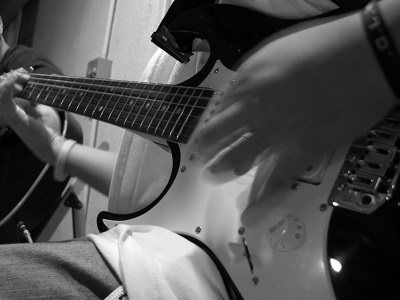Using Octaves Correctly in Guitar Riffs
 Octaves sound powerful. That being said, if you want your riffs to sound powerful, an easy way to achieve that is through the use of octaves. In this article, we will discuss how to implement octaves into your playing.
Octaves sound powerful. That being said, if you want your riffs to sound powerful, an easy way to achieve that is through the use of octaves. In this article, we will discuss how to implement octaves into your playing.
The first thing you should do before implementing octaves is learning your octave placements. No matter what tuning you are in, the octave of the note you are playing will always be twelve frets away on the same string.
Take for instance an open low E. If you move twelve frets up from an open low E, you come to the twelfth fret (twelve frets from open). This note is also an E.
An octave is the same exact note only a value higher. But having an octave twelve frets away isn’t always useful when making guitar chords.
More About Octaves
All octaves can be located two strings away, two or three frets away (only in dropped tuning, in which case two strings away on the same fret). Take for instance the open low E again.
If we play it as the open note, then move two strings away (which will bring us to the D string) and two frets away (which will bring us to the second fret on the D string) we get the note E.
This is our octave, and it is much closer. If we play an open G and move two strings away (which will bring us to the high E) and three frets away (which will bring us to the third fret of the high E) we get the note G, which is our octave.
Another way to find your octave is to move four or five strings back on the next string. If we fret the fifth fret of our low E, we get A. Play the open A string and we have our octave. Play the fourth fret on the G string for the note B, then play the B string open. This is yet another octave.
So How Can We Put All Of These Octaves To Use?
It depends on the circumstance. If you are playing a simple single note grouping riff, octaves can be used to turn single notes into powerhouses. If you are playing chords, you can expand the chord shape and make it sound larger by adding an octave.
If you are playing a flashier riff that is closer to a lick, sliding upwards to octaves can add more texture. Octave placement also helps to discern harmonies. If you want to make a lick more powerful without changing its note values, you can play the same riff twelve frets up to harmonize with the same exact notes.
Octave use is all about practice. Try implementing octaves in different ways. Experiment with different uses, such as chords, slides, and even open note hammer ons. This key is to discern what sounds good, and what sounds bad.
Octaves won’t always sound best. Sometimes, riffs sound better without harmonies. Keep this in mind; never force something that does not sound right. Have fun, and good luck!
Get Inspired By Awesome Guitar Instructors Today!
GuitarTricks.com is an online guitar learning website that offers lessons that are easy to understand and use. With more than 4,000 video guitar lessons, you are personally coached by more than 45 different instructors!
Try Guitar Tricks with a 14-days free trial now!







Leave A Comment